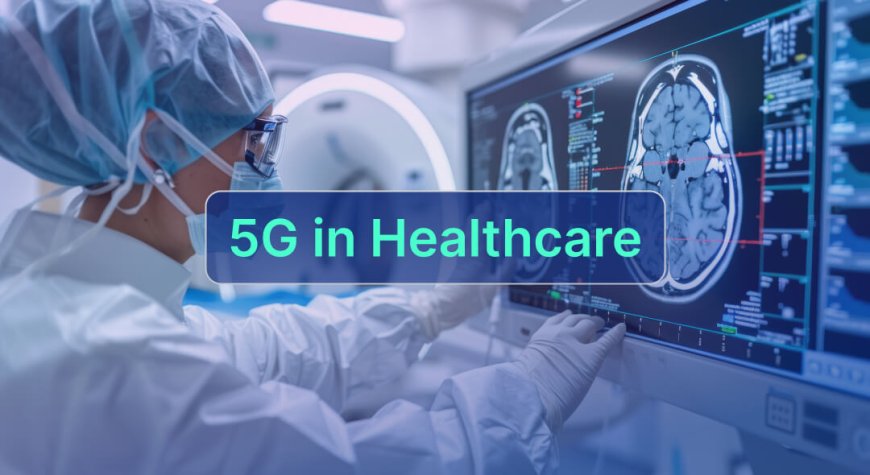How 5G Technology is Reshaping Healthcare Apps

The rapid evolution of technology has brought transformative changes to the healthcare industry, and 5G is at the forefront of this revolution. With its unprecedented speed, low latency, and enhanced connectivity, 5G technology is redefining the capabilities of healthcare apps, paving the way for innovative solutions and seamless patient care.
Healthcare app development services are leveraging 5G to build applications that offer real-time communication, advanced telemedicine, and enhanced patient monitoring. This article explores how 5G technology is reshaping healthcare apps and transforming the delivery of healthcare services.
1. Enhanced Speed and Low Latency
One of the most significant advantages of 5G technology is its ability to deliver data at lightning-fast speeds with minimal delay. This capability is a game-changer for healthcare apps that rely on real-time data transmission.
- Telemedicine: With 5G, video consultations between doctors and patients are smoother, offering HD-quality visuals and crystal-clear audio without buffering or interruptions.
- Wearables: Data from wearable devices is transmitted instantly, enabling real-time monitoring of vital signs such as heart rate, glucose levels, and oxygen saturation.
For healthcare app development services, this enhanced speed ensures that apps can handle large volumes of data efficiently, improving user experiences and patient outcomes.
2. Revolutionizing Remote Patient Monitoring
5G enables seamless connectivity between devices, making remote patient monitoring more effective than ever. Healthcare apps integrated with Internet of Things (IoT) devices can collect and transmit patient data to healthcare providers in real time.
For example:
- Patients with chronic diseases can use apps to monitor their health metrics continuously.
- Doctors can receive alerts about abnormal readings, enabling timely interventions.
This continuous monitoring reduces hospital visits and empowers patients to manage their health from home.
3. Advanced Telemedicine and Virtual Care
Telemedicine has become a cornerstone of modern healthcare, and 5G is taking it to the next level. The high-speed connectivity provided by 5G allows for advanced telemedicine features, such as:
- Augmented Reality (AR) and Virtual Reality (VR): Doctors can use AR/VR tools to guide patients or train medical students remotely.
- Remote Diagnostics: Specialists can analyze high-resolution medical images, such as CT scans or X-rays, through healthcare apps in real time.
By integrating 5G, healthcare app developers can create sophisticated telemedicine platforms that bridge gaps between patients and providers, regardless of location.
4. Supporting Real-Time Surgical Assistance
5G technology is enabling healthcare apps to support remote surgeries and real-time surgical assistance. With near-zero latency, 5G ensures that data is transmitted instantaneously, making remote surgeries possible.
Healthcare apps equipped with 5G can:
- Facilitate collaboration between surgeons and experts across the globe.
- Stream live surgery footage in ultra-high definition for educational or consultative purposes.
These advancements are particularly beneficial for remote or underserved areas, where access to specialist care is limited.
5. Improved Data Analytics and AI Integration
The speed and bandwidth of 5G enhance the capabilities of healthcare apps to process and analyze large datasets in real time. This is critical for apps that use artificial intelligence (AI) to:
- Predict health outcomes based on patient data.
- Provide personalized recommendations for treatment and lifestyle changes.
- Detect anomalies in medical images or lab reports.
For healthcare app development services, 5G enables the seamless integration of AI, making apps smarter, faster, and more reliable.
6. Revolutionizing Emergency Care
5G-powered healthcare apps are proving to be invaluable during medical emergencies. They facilitate faster communication between first responders, hospitals, and patients, ensuring timely care.
Key applications include:
- Ambulance Connectivity: Real-time transmission of patient data from ambulances to emergency rooms, helping doctors prepare for incoming cases.
- AR Navigation: Guiding first responders to locate victims in complex environments using AR-enabled healthcare apps.
By reducing response times and improving coordination, 5G is saving lives and enhancing emergency care systems.
7. Seamless Integration with IoT Devices
The synergy between 5G and IoT is revolutionizing healthcare app development. IoT devices, such as smartwatches, fitness trackers, and medical implants, generate vast amounts of data that can now be transmitted instantly through 5G networks.
For instance:
- Post-Surgery Recovery: IoT-enabled apps can monitor recovery progress and send alerts if complications arise.
- Chronic Disease Management: Continuous glucose monitors (CGMs) and smart inhalers transmit data to apps for better disease control.
5G-powered apps ensure that IoT devices operate without interruptions, providing users with a seamless healthcare experience.
8. Empowering Rural and Underserved Areas
5G's extensive coverage capabilities ensure that even rural and underserved regions can benefit from advanced healthcare apps. Telemedicine platforms powered by 5G provide:
- Access to specialists in urban centers.
- Real-time consultations and diagnostics for patients in remote areas.
This democratization of healthcare services reduces disparities and ensures equitable access to quality care.
9. Enhanced Security and Data Privacy
The introduction of 5G comes with improved encryption protocols and network security measures. For healthcare apps, this means better protection of sensitive patient data, such as medical histories and real-time health metrics.
Compliance with regulations like HIPAA is easier to achieve with 5G's robust security features. By prioritizing data privacy, healthcare app development services can build trust among users and healthcare providers alike.
10. Scalability for Future Innovations
5G technology provides the infrastructure needed to support future advancements in healthcare app development, such as:
- Digital Twins: Creating virtual replicas of patients to simulate treatment outcomes.
- Personalized Medicine: Tailoring treatments based on real-time data and genetic information.
- Edge Computing: Processing data closer to the source (e.g., wearables) for faster insights.
With 5G, healthcare apps can scale effortlessly to accommodate these innovations, ensuring they remain relevant and impactful.
Conclusion
5G technology is reshaping the landscape of healthcare apps by unlocking new possibilities for telemedicine, remote monitoring, and real-time care. Its speed, low latency, and reliability empower healthcare app developers to create solutions that improve patient outcomes, reduce costs, and enhance accessibility.
For healthcare app development services, 5G represents a significant opportunity to revolutionize how healthcare is delivered. As the technology continues to evolve, its impact on healthcare apps will only grow, driving innovation and transforming the future of medicine.
By embracing 5G, the healthcare industry is taking a bold step toward a more connected, efficient, and patient-centric future.
What's Your Reaction?

















![[???????????????????????????? ???????????????? ????????????????????????] Can I Change My Name On Expedia Airlines](https://news.bangboxonline.com/uploads/images/202501/image_430x256_67915cce6df9e.jpg)


